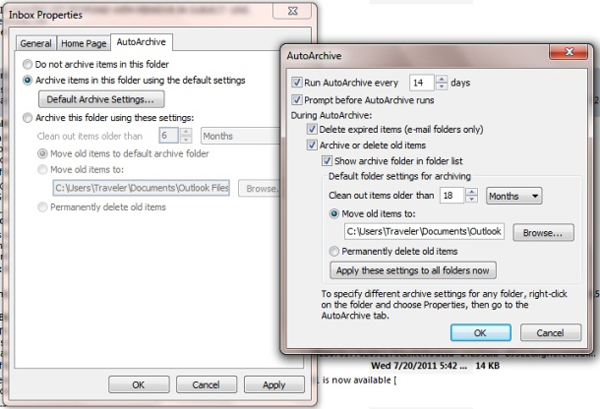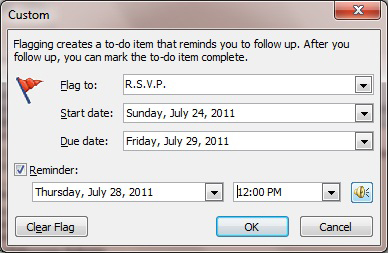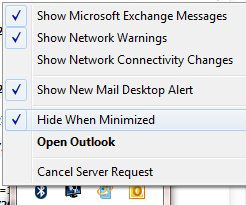6 ways to work faster in MS Outlook
QuanTriMang - Companies big or small rely heavily on Word data, Excel spreadsheets and PowerPoint presentations to complete daily tasks. In some ways, Outlook is a little less advantageous than the three 'brothers' mentioned above. However, the real important part of Microsoft's popular office suite is email, contact management, scheduling tasks.
-
List of shortcuts in Outlook 2016 when working with Mail
6 tips for Outlook 2010, 2007 and 2003 below will help you spend less time opening email messages, remembering reminders, dragging files and sending them as attachments, adding words to check spelling , clear the taskbar space and improve the shortcut list to save time when using Outlook.
Store a calendar message folder
Many people do not need to store emails on Outlook and choose to delete old messages or simply leave them filled with mailboxes. However, most companies limit the size for each individual Outlook account. So, you can get a notification from an IT staff member to store some old emails.
Storage can help the folder not be filled, but when retrieving saved messages it will take longer than messages that have not been archived. Sometimes, users may need to access messages older than the default Outlook auto-storage time of 6 months. You can also stop all Outlook archiving operations or let this software store only certain folders and messages.
Note : Outlook 2010's Clean Up feature automatically removes what this software recognizes as extra messages in a certain folder. This is not the same as storing old email.
To enable auto-archive for email in a particular folder, right-click the folder and select Properties → AutoArchive . By default, the archive feature will run 14 days and apply to messages older than 6 months at the time of execution. To change the default settings, select the Default Archive Settings button to open the AutoArchive dialog box. Here, you can change the storage frequency, the time to store unsaved messages and the location of the archive.pst file.

Adjust auto-archive settings to edit storage frequency, storage and other options.
To customize the storage settings of a folder, right-click the folder and select Properties → AutoArchive , select " Archive this folder using these settings " and make a choice. To prevent a certain personal message from being stored, open it and click File → Info → Properties in Outlook 2010 and 2007 or File → Properties in Outlook 2003. Click on " Do not AutoArchive this item ".
Create reminders with more information
Outlook allows users to assign a certain message with a color list or mark them with flags. Even with the support of these signs, you still need support to remember important messages. To add a description that appears right next to the flag when you open the message, select Follow Up → Custom and enter the word or phrase explained.
To add a reminder that appears right in the tasks and schedule, right-click the message and select Follow Up → Add Reminder . In the " Flag to " section, add a description for the corresponding action. This text will appear at the top of the message along with other information.

Adding a description for the reminder will appear at the top of the message to remind yourself of the reason for a certain task or reminder.
How to send attachments quickly
A typical method to attach a file to an email is to open a new message, select the paper clip icon and navigate to the file to be attached at the window that appears later. If you are in Windows Explorer or any folder window, you may have to click on the file and select Send to → Mail recipient . A new message creation window will appear with your default email software.
Users can save more time by dragging files directly into your Outlook mailbox, like opening a new message with the file attached automatically.
Customize spell checking in Outlook
Spelling mistakes are unprofessional, making Outlook's spell checking feature indispensable for anyone. No spelling dictionary can include all the words you want to use in your daily work. Users can make Outlook's spell checking feature more accurate by adding the name and terminology you frequently use. In Outlook 2010 and 2007, select File → Options → Mail → Spelling and Autocorrect → Custom Dictionaries → Edit Word List . Add your new term here and click OK twice.
In Outlook 2003, click Tools → Options → Spelling and select the Edit button under " Edit custom dictionary ". Click through through the warnings, if necessary, add the new term to the Custom.dic file. Next, click File → Save and File → Exit . This tip does not save you time but can help text / email look better.
Microsoft provides more information about customizing dictionaries in Outlook and Office 2010 applications on the Office Support page.
Minimize Outlook to the notification area.

Click Outlook to display from the taskbar when the software is minimized by selecting Hide When Minimized after right-clicking on the Outlook icon in the notification area.
Over a period of use, your taskbar will be filled by minimized applications, even if you select multiple open windows together. (To set up so, right-click on the taskbar, select Properties → Taskbar , and select " Always combine, hide labels " in the menu next to " Taskbar buttons ").
Users can let Outlook exit the taskbar by placing a thumbnail icon in the notification area. To do this, right-click the Outlook icon in the notification area and select Hide When Minimized . Outlook will then only minimize the notification area, not the taskbar.
Quickly switch to another office application
If you have opened an office application, you may then want to work more with another application. You can open new Word data, Excel spreadsheets, PowerPoint presentations or other types of files in Outlook by pressing the Ctrl + Shift + H shortcut. This shortcut will open the New Microsoft Office Document dialog box. Just select the file type you need and click OK .
The Microsoft Office page lists a list of shortcuts for Outlook 2010, Outlook 2007, and Outlook 2003. Here is a shortcut for email:
- Switch to Inbox: Ctrl + Shift + I
- Switch to Outbox: Ctrl + Shift + O
- Select account to send email: Ctrl + Tab (focus on To line), then move to Accounts button
- Send: Alt + S
- Reply to a message : Ctrl + R
- Answer all for a message : Ctrl + Shift + R
- Mark a message other than junk mail: Ctrl + Alt + J
- Display blocked content (in a message) : Ctrl + Shift + I
- Upload to a folder: Ctrl + Shift + S
- Check the new email: Ctrl + M or F9
- Go to the next message: Arrow up
- Switch back to the previous message: Down arrow
- Move up the top row: Alt + up arrow
- Move down to the bottom row: Alt + down arrow
- Create a new message : Ctrl + N
- Open a new message received: Ctrl + O
- Convert HTML or RTF messages to plain text : Ctrl + Shift + O
- Add a Quick Flag to a message: Insert
- Display Flag for Follow Up dialog box: Ctrl + Shift + G
- Mark read: Ctrl + Q
- Display download menu , change download settings or add senders to the Safe Senders List list: Ctrl + Shift + W.
You should read it
- Add new, delete, edit Outlook Email Alias like?
- 4 ways to manage email effectively
- Instructions for sending free SMS via Outlook
- How to Set Up Email in Outlook Latest 2022
- Instructions on how to share contacts in Microsoft Outlook
- How to insert an Outlook contact in Word
- How to Block Contacts on Outlook Mail
- Move daily email to a folder in Outlook
- GO Contact Sync: sync contacts Gmail and MS Outlook
- Shortcuts in Outlook.com
- How to not save sent email in Outlook 2016
- What is Outlook Mail? How to register and use Outlook mail for beginners
May be interested

Add a name to the Junk Email list in Microsoft Outlook

Block senders, add new email notifications in Outlook, Thunderbird

Create and use the Template in Outlook 2010

Instructions for configuring and setting up email with Thunderbird

Transfer email from Outlook to Thunderbird

Declare Gmail on Outlook 2007





 10 good tips to help you work more efficiently on Outlook
10 good tips to help you work more efficiently on Outlook 7 ways to work faster in Windows 7
7 ways to work faster in Windows 7 Instructions on simple ways to back up Outlook data
Instructions on simple ways to back up Outlook data List of Outlook 2016 shortcuts when working with Mail
List of Outlook 2016 shortcuts when working with Mail How to set up automatic replies on webmail Outlook
How to set up automatic replies on webmail Outlook Discover more interesting with Outlook
Discover more interesting with Outlook